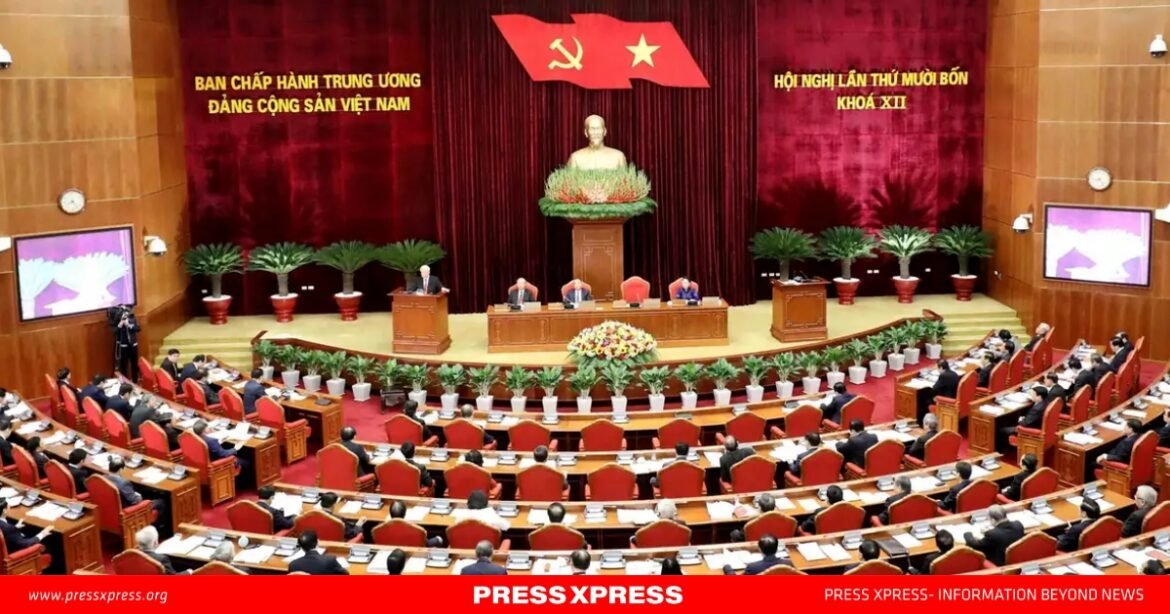Vietnam’s Communist Party (CPV) is poised to undertake sweeping reforms aimed at streamlining its political apparatus. On December 1, the CPV’s Politburo convened a hybrid national conference to discuss structural optimization within the political system, following a Central Committee decision on November 25. Le Minh Hung, chairperson of the Central Commission for Personnel Affairs, unveiled a comprehensive plan for overhauling Vietnam’s “political system.” Closing the conference, CPV General Secretary To Lam underscored the importance of these changes, framing them as part of broader institutional reforms to enhance governance efficiency and drive transformative economic growth.
The Overlap of Party and State
The term “political system,” first introduced by the CPV in 1989, describes a dual structure of state and party agencies operating in parallel, alongside mass socio-political organizations under CPV oversight. This overlapping framework often results in duplicated functions and blurred lines of authority. Party agencies frequently intervene in matters that legally fall under executive branch jurisdiction, creating inefficiencies, policy inconsistencies, and sluggish decision-making.
Critics argue this structure is increasingly misaligned with Vietnam’s doi moi economic reforms, initiated in 1986 to liberalize and modernize the economy. Calls for systemic reform have emerged from both experts and former high-ranking party officials, stressing the need for a leaner and more efficient apparatus to match the nation’s ambitions.
The Nuances of “Institutional Reform”
While “political reform” remains a sensitive term in Vietnam, institutional reform—referred to cautiously in CPV discourse—focuses on refining laws, consolidating agencies, and enhancing operational efficiency. These efforts aim to streamline the state apparatus, reduce administrative layers, and improve productivity without challenging the one-party system. By avoiding the semantics of political reform, the CPV seeks to preclude debates on multi-party governance while advancing pragmatic changes.
Vietnam’s institutional bottlenecks have become a critical obstacle to economic progress. Despite nearly four decades of doi moi, Vietnam, now a lower-middle-income country, lags behind Asian peers such as South Korea, Taiwan, and Singapore in terms of development speed. General Secretary To Lam has identified institutions as the “bottleneck of bottlenecks,” urging urgent reforms to create a “lean, compact, strong, efficient, effective, and impactful” governance framework.
A History of Incremental Reforms
Vietnam has previously implemented structural adjustments. In the executive branch, the number of ministries and ministerial-level agencies decreased from 36 in the 1990s to 20 by 2021. Similarly, the CPV streamlined its departments during 2007-2012, only to reverse some of those changes by re-establishing dissolved commissions in 2013. Despite these efforts, challenges persist, and deeper reforms are now on the horizon.
An Ambitious Plan for 2025
Under To Lam’s leadership, the CPV is set to embark on what some are calling an institutional revolution. According to internal sources, key changes will include the consolidation of several ministries and party commissions. Notable plans include merging the Ministry of Finance with the Ministry of Planning and Investment, and combining the Ministry of Natural Resources and Environment with the Ministry of Agriculture and Rural Development into a “Ministry of Sustainable Resources and Agriculture.” By 2025, the number of government ministries will shrink to 15, with corresponding reductions in party commissions and National Assembly committees.
This restructuring is expected to have significant ripple effects, including major personnel shifts. Le Hoai Trung, head of the Central Commission for External Affairs, is slated to become the minister of foreign affairs, while Nguyen Thi Hong, current State Bank governor, is poised for a promotion to deputy prime minister.
The Challenges Ahead
While To Lam has framed these changes as a necessary revolution, resistance from within the party and government is inevitable. Institutional reforms threaten entrenched interests, and their success hinges on the CPV leadership’s ability to unite the party behind these changes. To Lam’s political capital will face a critical test in the lead-up to the 14th Party Congress in 2026. If he succeeds, his position as CPV general secretary will likely be secured for another term, cementing his legacy as a reformist leader.
Implications for Vietnam’s Future
Vietnam’s institutional reforms signal a pivotal moment in its governance and economic trajectory. By addressing long-standing inefficiencies, the CPV aims to align its political framework with the demands of a modern, dynamic economy. However, whether these changes will yield the desired breakthroughs depends on their execution and the party’s willingness to prioritize national progress over internal resistance. As the world watches, Vietnam’s ability to turn institutional intent into impactful action will shape its role as a regional economic leader.


